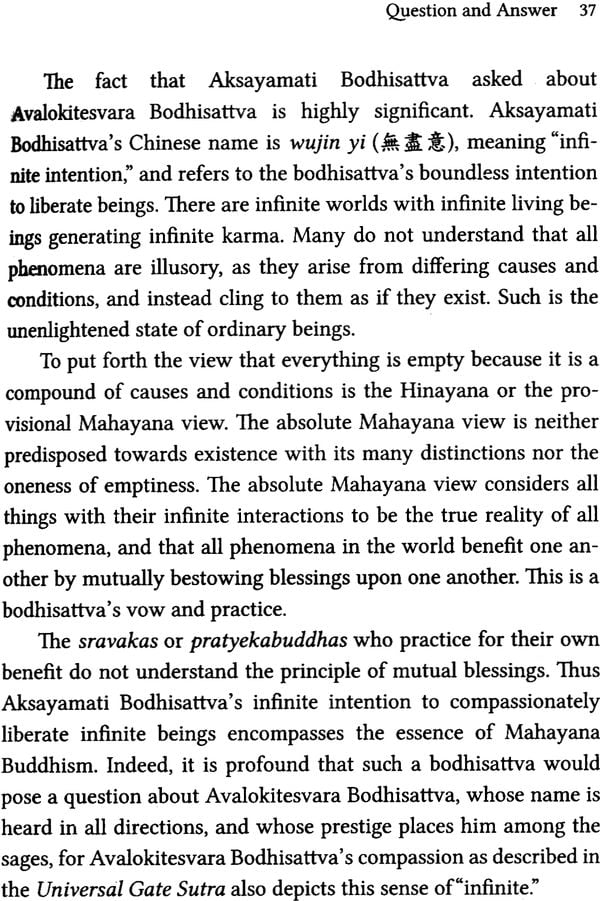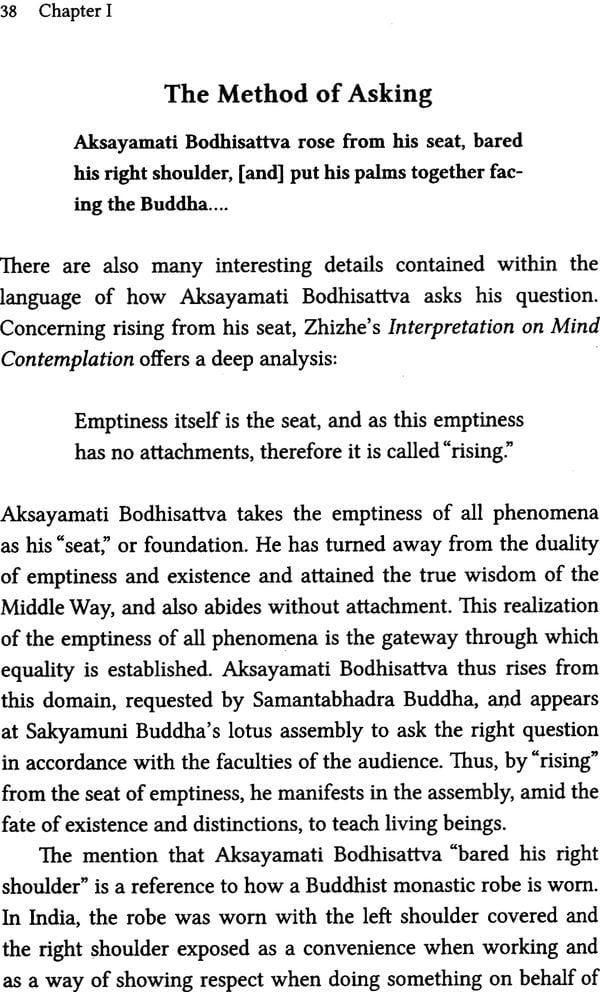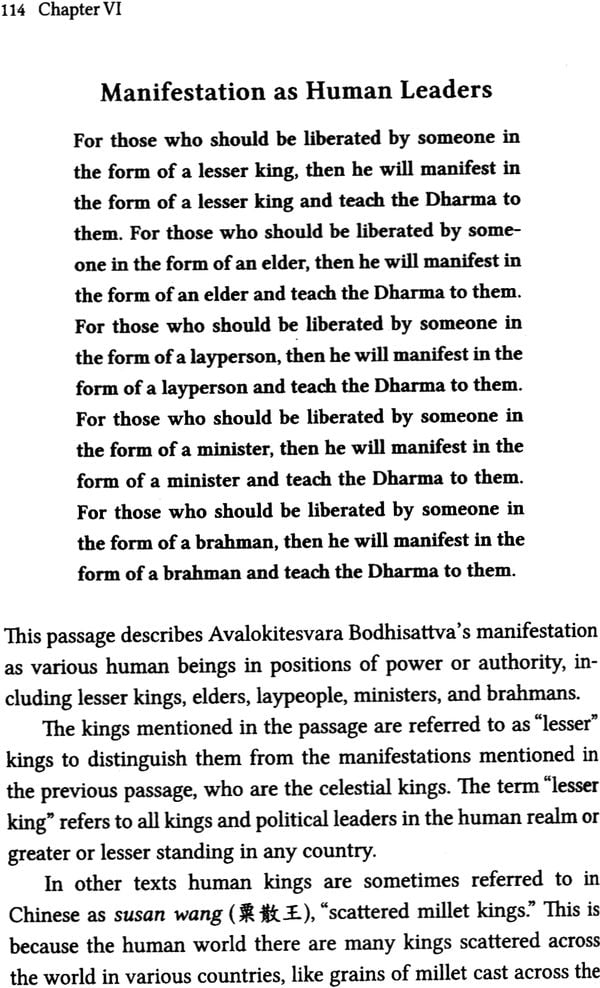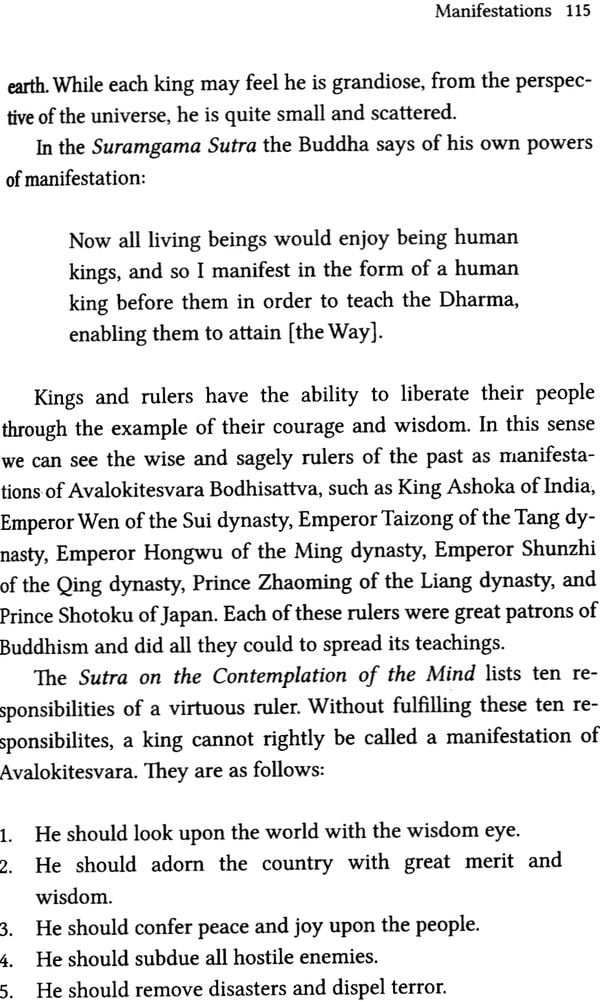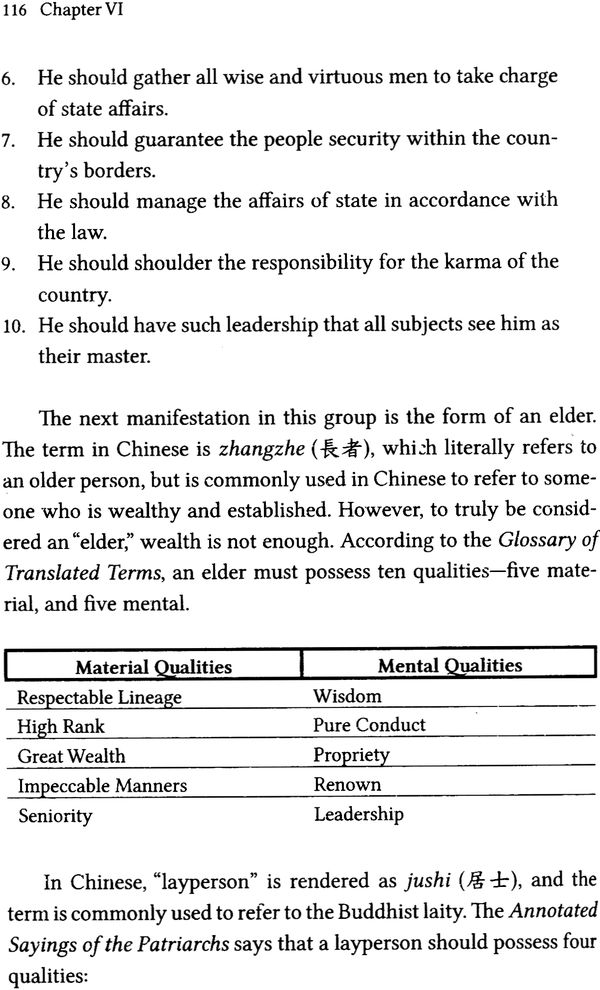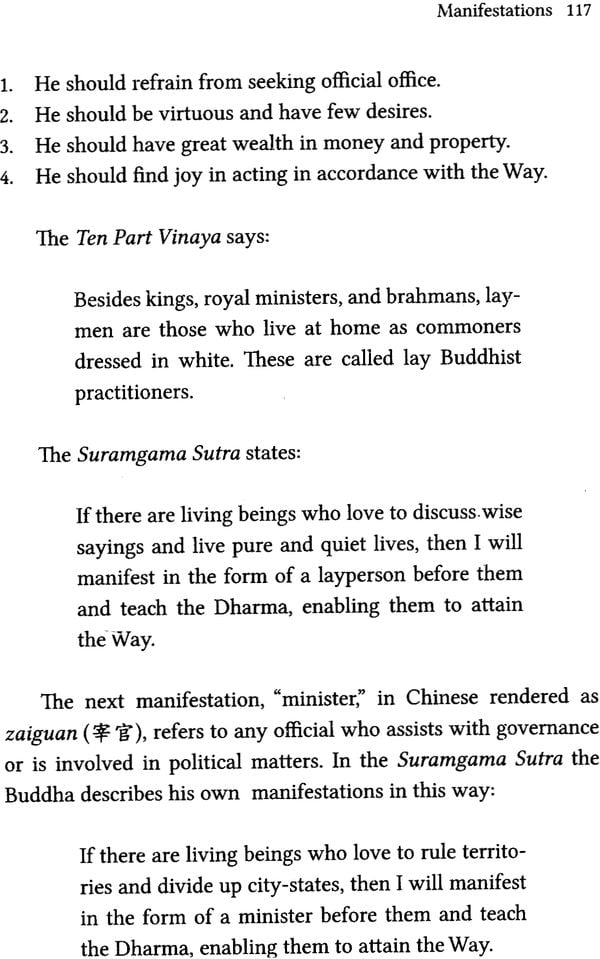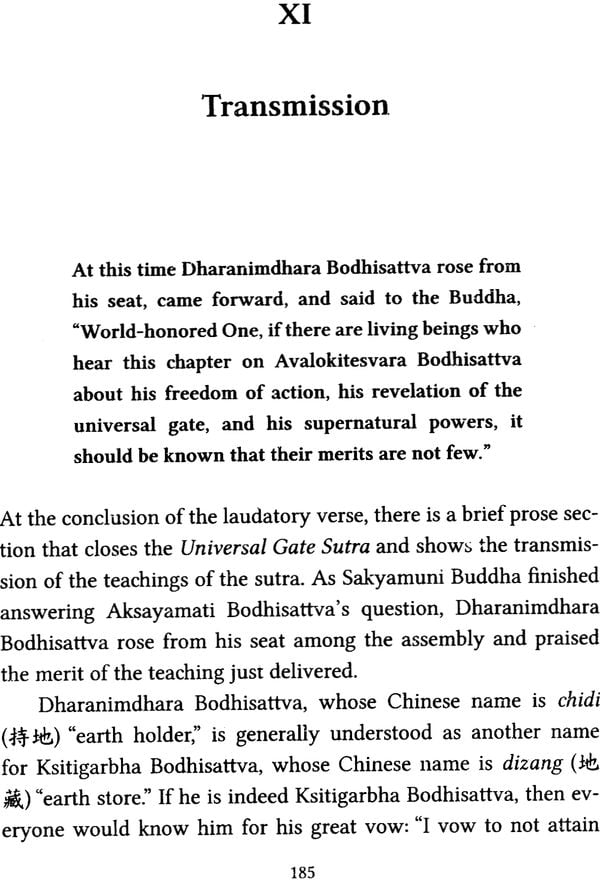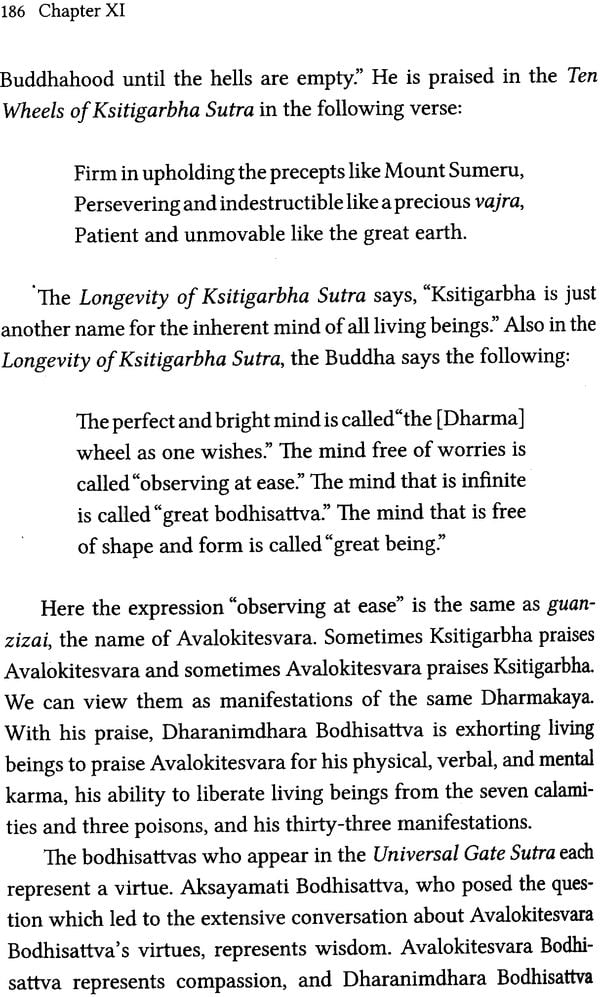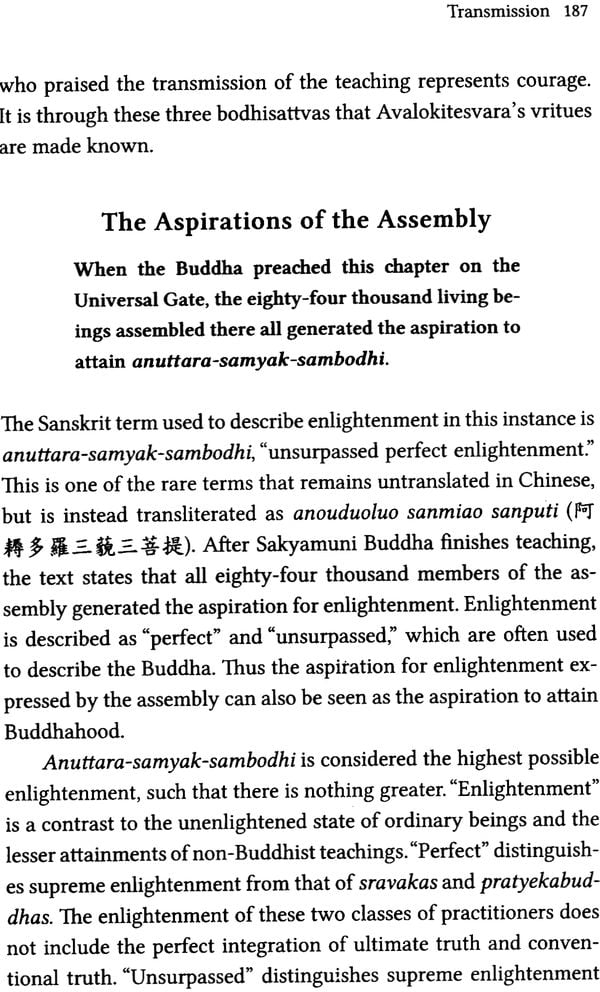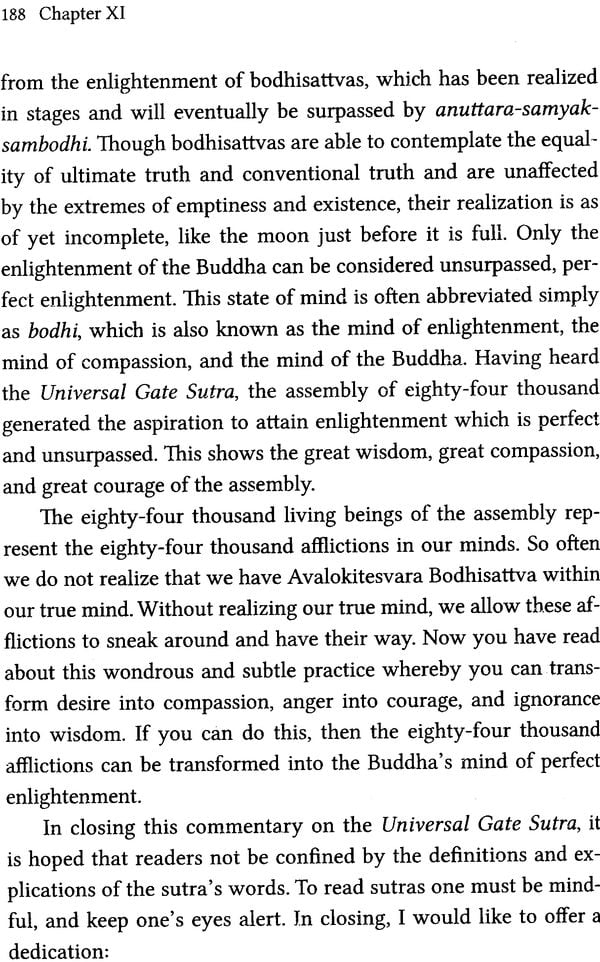
The Universal Gate (A Commentary on Avalokitesvara's Universal Gate Sutra)
Book Specification
| Item Code: | NAJ185 |
| Author: | Venerable Master Hsing Yun |
| Publisher: | Buddha Light Art and Living Pvt Ltd |
| Language: | English |
| Edition: | 2011 |
| ISBN: | 9789382017080 |
| Pages: | 250 |
| Cover: | Paperback |
| Other Details | 8.5 inch X 5.5 inch |
| Weight | 280 gm |
Book Description
The Compassionate visage of Avalokitesvara Bodhisattva, better known as Guanyin in Chinese has been a source of inspiration and devotion for centuries. The Universal Gate provides a new translation of Avalokitesvara's Universal Gate Sutra, the Buddh's scriptural account of this celebrated sage and his power to manifest in whatever form is necessary to help others. Chanted and memorized throughout East Asia, this powerful tet is rich with symbolic significance and striking, memorable images. This edition also includes a line-by-line commentary that unpacks the sutra's fantastic description, and relates them to personal practice and the wider buddhist teachings.
Venerable Master Hsing yun is a Chinese Buddhist monk, author , Philanthropist, and founder of the Fo Gaung Shan monastic order, which has branches throughout Asia, Europe , Africa , Australia, and the Americas . Ordained at the age of; twelve in Jiangsu Province , China , Hsing Yun has spent over seventy years as a Buddhist monk building what he calls “ Humanistic Buddhism” – Buddhism that meets the needs of people and is integrated into all aspects of daily life.
In 1949, Hsing Yun went to Taiwan and began to nurture the then burgeoning Buddhist culture on the island. Early on his monastic career, he was involved in promoting Buddhism through he written word. He has served as an editor and contributor for many Buddhist magazines and periodicals, authoring the daily columns “Between Ignorance and Enlightenment.” Dharma Words,” and Hsing Yun’s Chan Talk.” In 1957, he started his own Buddhist magazine, Awakening the world, and in 2000, the first daily Buddhist newspaper, the Merit times.
Hsing yun has authored more than thirty books on how to bring happiness, peace , compassion and wisdom into daily life. These works include the song of silence, the Biography of Sakyamuni Buddha , and National master Yulin. He also edited and publish the fo Gaung Encyclopedia, the most authoritative Buddhist reference work in the Chinese language . His contributions have reached as far as sponsoring Buddhist music and art to creating Buddhist Programming fro television, radio, and the stage.
Hsing yun resides at Fo Gaung Monastery in southern Taiwan and continues to keep a very active schedule, attending numerous speaking engagements each year. In 2010 he delivered around 120lectures and gave nearly 30 interviews for Television and radio . He continents to write a daily column for the Merit Times, as well as to produce one stroke calligraphy paintings. He is also the acting president of Buddha’s Light International associations (BLIA), the Worldwide lay Buddhist service organization.
Initially published in Taiwan in 1953, the Commentary on Avalokitesvara’s Universal Gate Sutra was the first book published by Venerable Master Hsing Yun, and his first success. At age twenty -six, Master Hsing Yun had already contributed to a number of Buddhist periodicals, both as an editor and contributed, including Raging billows, Splendid Light , and Life Monthly . The success of this commentary cannot be undervalued for building his reputation as a teacher , writer, and Buddhist leader of note in Taiwan.
In the postscript to the first edition , Master Hsing yun calls his commentary a translation, citing a 1934 commentary written in Japanese by a monastic named Master Zhidao. Though such a work may have established the interpretive framework for the published commentary, the authorship is substantially Master Hsing Yun’s The Commentary features the beginnings of what would come to be known as master Hsing Yun ‘s style ; Buddhist teachings interspersed with humor, history , and poetry, and directly addressing the concerns of the audience.
The presents English edition is in many ways more robust than the first edition published over fifty years ago. The Text and the sutra have been translated, and the reader has been provided with a glossary of Buddhist terms and a list of the texts cited within the commentary. The The Chinese text of the Universal Gate Sutra has also been provided as an appendix, accompanied with pinyin pronunciations of each character for chanting.
Etymology is a major concern of the commentary ,and perhaps the most difficult to render into English . Instances when words and their meanings are discussed in the abstract have been translated into English, while passages dealing with the concerns of translating Indic and Buddhist concepts into Chinese include some of the Chinese character s in question. This is not meant to be daunting to the English reader , but is provided t make him more aware of the mechanics at play in a text that has been translated through many languages.
The structure of the chapters has been changed in the English edition so that each chapter is of roughly the same size, and some of the larger, quoted sections have been broken up into several smaller ones. This has been done in an attempt to make the text more well - suited fro group discussion and Dharma classes, In addition, the margins of the sutra text include the page numbers of the commentary the references that paragraph.
Though published over fifty years ago, Master Hsing Yun’s commentary on the Universal Gate Sutra has continued to be read and enjoyed in Asia , and it is hoped that this English edition can continue to share this important sutra with a new, ever widening audience.
Through he is called Guanyin in China, Kannon in japan, and Gwan-eum in korea, regardless of the name, there is no one in these countries who is not familiar with avalokitesvara Bodhisattva . In these countries the belief in Avalokitessvara Bodhisattva. In these countries the belief in Avalokitesvara is not found only in Buddhist monasteries and nunneries, nor is it limited exclusively to Buddhist . wherever people live , be it in cities or rural villages , upon remote mountain tops or along the seashore , just about every family Keeps and venerates a statue of Avalokitesvara Bodhisattva.
How has Avalokitesvara Bodhisattva become he focus of faith for so many people ? the Buddhist teaching make mention of numerous bodhisattva; the Lotus Sutra itself mentions an assembly that contains more than eighty thousands bodhisattvas Among this assembly eighteen great bodhisattvas are specifically named , and even among these eighteen there are some bodhisattvas whom no one especially venerates and of which very little is known . Yet among these , Avalokitesvara Bodhisattva has become the bodhisattva hat everyone knows about and believes in. Why ? Such answers can be found by reading the universal Gate sutra.
The Lotus Sutra , whose full title is the Lotus Flower of the Wondrous dharma Sutra , is a magnificent sutra which describes sakyamuni Buddha’s reason for appearing in the world . The Universal Gate just mentioned is only one f the twenty – eight chapters of the Lotus sutra. The Universal Gate sutra provides a description of Avalokitesvara Bodhisattva and how he serves as a “Universal gate “ of benefits for sentient beings . because e of its specially and popularity , the Universal Gate sutra I soften chanted on its own , and circulates as a separate text.
Originally written in Sanskrit , the translation of the Lotus discussed within was translated into Chinese by Kumarajiva (344-413), a Buddhist monk who lived during the later Qindynasty Kumarajiva is considered one of the four great Buddhist translator of China , the other three being paramartha (499-569), Xaunzang (602- 664), and Amoghavajra (705- 774). Among these four, Kumarajiva occupies an extremely important position both in terms of his understanding of the teachings and his skill as a translator. In he case of the Lotus sutra , several other translations appeared both before and after Kumarajiva’s but Kumarjiva’s version has remained the most popular and widely circulated. Additionally , when Master Zhizhe (538-597) founded the Tiantai school, a Buddhist school whose central text is the Lotus sutra , He did so based upon Kumarajiva’s translation such details only further illuminate the extraordinary qualities of Kumarajiva and the innovations of his translation. Kumarjiva was born in Quici, a central Asian country hat is now part of hcina’s Western Regions. At the age of seven he went his mother to visit many famous Buddhist teachers and thoroughly studied the Buddhist sutras . Of special interest to Kumarjiva were the teachings of Nagarjuna (150-250), whose perspective on Prajana wisdom can be seen in kumarajiva’s translation of the Lotus sutra. Among Kumarjiva’s Disciples sengrui (ca.4th-5th cent.) and Daosheng (355-434) both of whose teachings led to the establishment of the Tiantai school.
When Kumarajiva first arrived in China more has fifteen hundred years ago, China was experiencing chaos wrought by the nomadic tribes to the north, forcing the Jin court south. A this time the capital of Jianye (modern Nanjing) was established on the lower reaches of the Yangzi river – later called the Eastern Jin dynasty. At the time , the commanding general , fu Jianchangan (modern Xian) Within the Yellow river Valley , which he called Qin and which later historians would call the former Qin dynasty. His general, Liu Gaung (337-339), employed his military prowess to subdue various parts of the Western regions, and received order to welcome Kumarajiva to China , but soon after , fu Jian was hit by a stray arrow during the Battle of Fei rive, and later died. With the End of his rule , yao chang (331-394) assumed power. This period would later be known as the Later Qin, or Yao –Qin.
Lu Gaung learned of the death of fu jian while on the road during a distant campaign, and as he had been consistently victorious throughout the western Regions, he established his own state in present –day Gansu Province , known as the later Liang dynasty. At the Time, Kumarjiva had arrived at Guzang, the capital of the Later Liang Dynasty . Later on, the Yao-Qin dynasty’s second ruler, Yao Xing (36-416), ascended the throne and become a devout followers of Buddhism. Yoa Xing lavished Kuamrjiva with gifts and, in the third year of the Hongshi era (401), welcomed him to Cahngan, constructing Ximaing Hall for Kumarjiava to alive in and xiaoyao Garden to serve as his translation center. This inaugurated a glorious period in Chinese Buddhist history.
Contents
| Editor's Preface | ix | |
| Introduction | 1 | |
| Avalokitesvara's Universal Gate Sutra | 23 | |
| I. | Question and answer | 35 |
| II. | The Seven Calamities | 51 |
| III. | The three Poisons | 77 |
| IV. | Two Wishes | 87 |
| V. | Exhortation to practice | 93 |
| VI. | Manifestation | 99 |
| VIII. | Offering of the Jeweled Necklace | 135 |
| VIII. | Verses on Avalokitesvara | 147 |
| IX. | Verses on Dangers | 155 |
| X. | Verses on virtues | 167 |
| XI. | Transmission | 185 |
| Universal Gate sutra Chinese Text | 191 | |
| List of Texts | 221 | |
| Glossary | 229 |
Sample Pages


